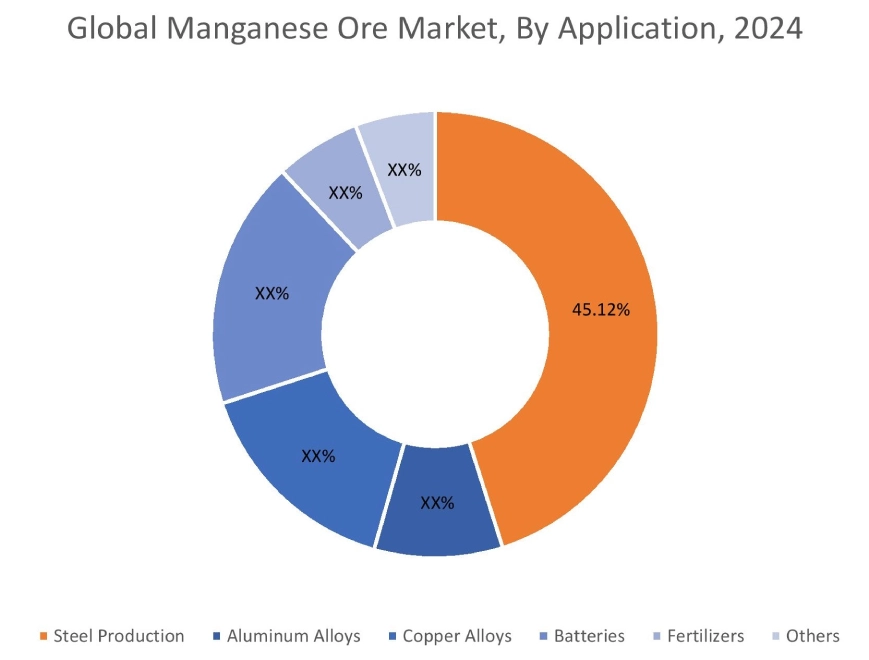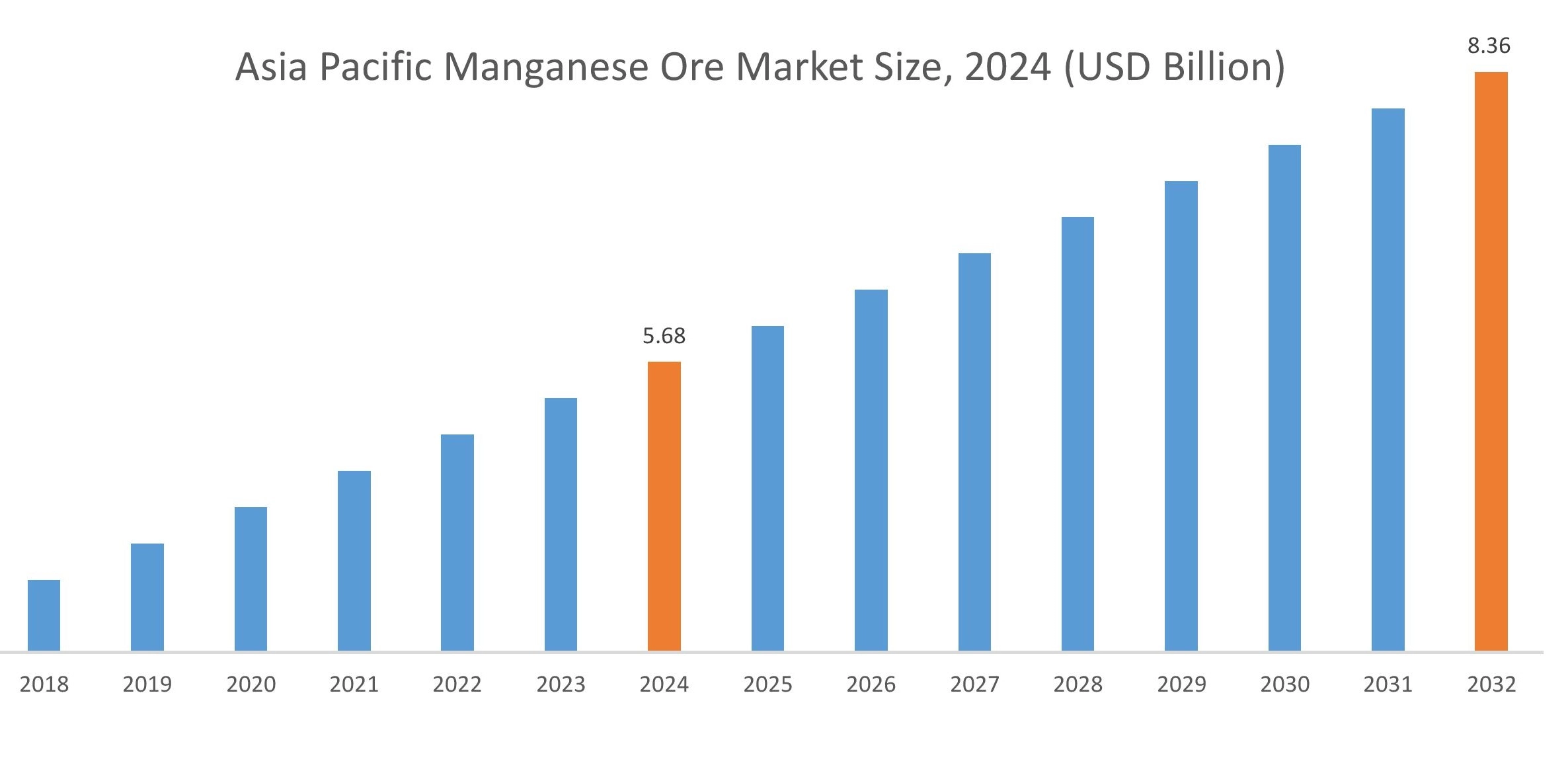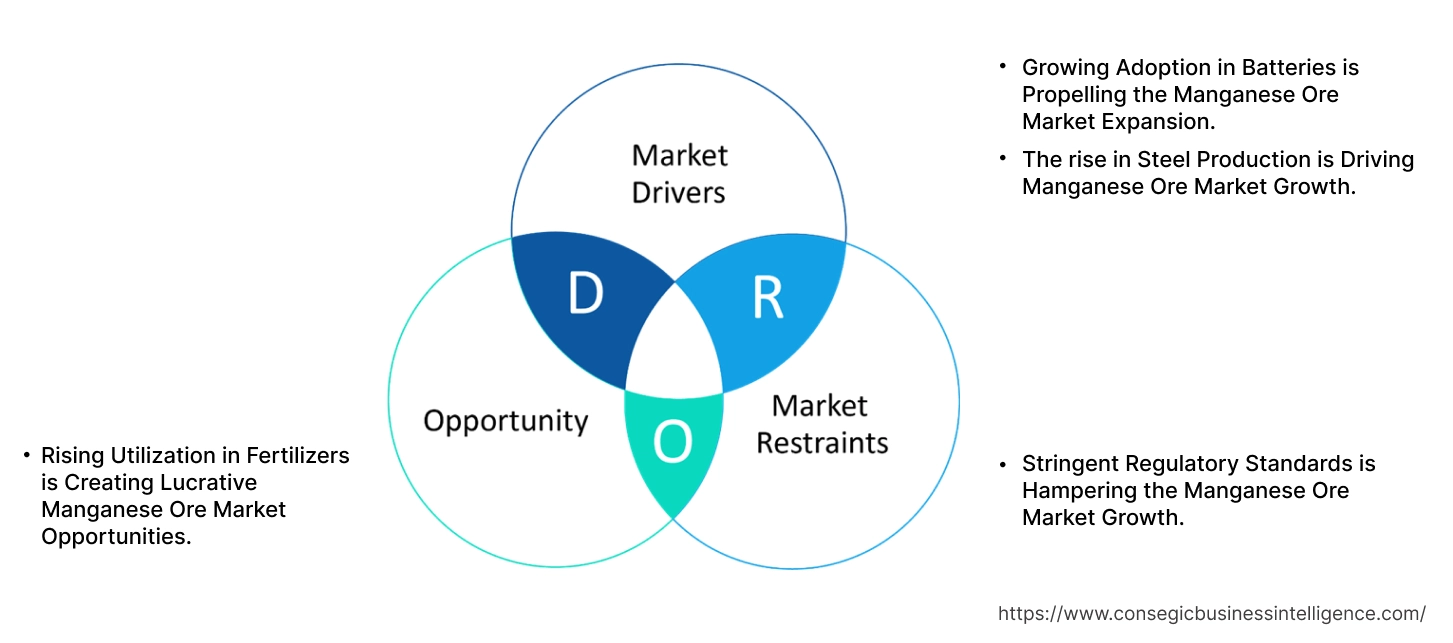Manganese Ore Market Size:
Manganese Ore Market size is growing with a CAGR of 6.1% during the forecast period (2025-2032), and the market is projected to be valued at USD 21.73 Billion by 2032 from USD 13.53 Billion in 2024. Additionally, the market value for the 2025 attributes to USD 14.32 Billion.
Manganese Ore Market Scope & Overview:
Manganese ore consists of rocks and minerals from which manganese is economically extracted. It is a primary source of manganese, which is a hard, brittle, silver-white metal that offers various industrial uses. The production process of this ore involves integrating mining techniques that are followed by refining to obtain pure manganese. The manganese ore industry consists of various types like pyrolusite (high Mn content), braunite, psilomelane, and rhodochrosite, each with distinct compositions and properties. Primarily driven by steel production where it enhances strength and hardness, manganese ore also finds crucial applications in aluminum and copper alloys, battery manufacturing as manganese dioxide, and as a vital component in fertilizers.
Manganese Ore Market Dynamics - (DRO) :
Key Drivers:
The rise in Steel Production is Driving Manganese Ore Market Growth.
Manganese ore acts as a powerful deoxidizer and desulfurizer, removing harmful impurities such as oxygen and sulfur that weaken steel. Additionally, manganese is a crucial alloying agent, significantly enhancing the steel's strength, hardness, toughness, and wear resistance. Even small additions of this ore, typically in the form of ferromanganese or silicomanganese alloys, improve the rolling and forging qualities of steel. The rise in the production of steel influences the use of this ore in them.
For instance,
- The data from the National Informatics Centre (NIC) states that the production of crude steel grew from 109.137 MT in 2019-20 to 144.299 MT in 2023-24 in India.
Thus, the production of crude steel influences the use of manganese. This drives the manganese ore market demand.
Growing Adoption in Batteries is Propelling the Manganese Ore Market Expansion.
Manganese ore plays a crucial role in the battery sector. It is primarily used as a component in the cathode material. The most significant application is in lithium-ion batteries, where manganese is mainly combined with other metals like nickel and cobalt (NMC) or used independently as Lithium Manganese Oxide (LMO). This ore improves the battery's stability, safety, and contributes to higher energy density and power output, mainly at a lower cost compared to other cathode materials such as cobalt.
For instance,
- The data by International Manganese Institute states that batteries represent a significant non-alloy application for manganese, consuming approximately 2-3% of global manganese production.
Thus, the adoption of this ore for the production of batteries is driving the market expansion.
Key Restraints:
Stringent Regulatory Standards is Hampering the Manganese Ore Market Growth.
The market faces significant hurdles because of the stringent regulatory standards imposed by various regulatory bodies worldwide. These regulations are generally designed to ensure product safety and efficacy. This generally includes thorough testing, extensive documentation, and lengthy approval processes. Compliance with these standards is time-consuming and costly, particularly for smaller companies or those developing novel ingredients. Concerns regarding the potential presence of impurities or hazardous substances in manganese have led to stricter quality control measures, requiring more rigorous testing and certification. Additionally, changes in regulatory guidelines or the introduction of stricter regulations disrupt established processes and require significant investments in research, development, and manufacturing to meet the new standards. These factors contribute to increased costs, delayed product launches, and limited market access, ultimately hindering the manganese ore market expansion.
Future Opportunities :
Rising Utilization in Fertilizers is Creating Lucrative Manganese Ore Market Opportunities.
Manganese ore is a source of essential micronutrient for plant growth. It is crucial for processes like photosynthesis, enzyme activation, and nitrogen assimilation. In fertilizers, the ore is mainly supplied in the form of manganese sulfate (MnSO₄), a water-soluble compound that plants readily absorb through the soil or foliage. Governments are investing in the development of novel fertilizers. The rise in the need for effective fertilizers is influencing the requirement for investment in developing novel solutions.
For instance,
- In 2024, S. Department of Agriculture (USDA) announced that it is investing in domestic fertilizer projects to strengthen competition for U.S. farmers, ranchers and agricultural producers. The Department is awarding $83 million in 12 states for projects through the Fertilizer Production Expansion Program (FPEP).
The investment creates potential for the development of novel fertilizers using manganese ore. Thus, as per the market analysis, the increasing demand for effective fertilizers to support agricultural productivity presents significant manganese ore market opportunities.
Manganese Ore Market Segmental Analysis :
By Type:
Based on the type, the market is categorized into pyrolusite, braunite, psilomelane, rhodochrosite, and others.
Trends in the type:
- The growing trend for lithium-ion batteries for various applications is influencing the utilization of pyrolusite.
The pyrolusite segment accounted for the largest market share in 2024 and is expected to grow at the fastest CAGR over the forecast period.
- Pyrolusite is a key manganese ore mineral, primarily composed of manganese dioxide (MnO₂), making it the most important commercial source of manganese.
- It is a black to grayish, mainly metallic-lustered mineral which is known for its relatively high manganese content.
- Pyrolusite is a naturally occurring form of manganese dioxide (MnO₂), which is a primary cathode material in various battery technologies, including alkaline lithium-ion, and various next generation batteries where its electrochemical properties assist energy storage and release.
- Companies are continuously developing batteries that consist of manganese dioxide.
- For instance, Maxell developed new cylindrical lithium manganese dioxide (CR) batteries. This showcases the continued importance of manganese dioxide in advanced battery technology.
- Thus, the application of pyrolusite for various applications is influencing the segment share currently and in the coming years.
By Application:
Based on the application, the market is categorized into steel production, aluminum alloys, copper alloys, batteries, fertilizers, and others.
Trends in the Application:
- There is a rise in trends for high-strength and low-carbon steel, driven by industry like electric vehicle production that necessitates the use of low-carbon ferro manganese.
- Growing trend for water soluble fertilizers that offer essential micronutrients is influencing the use of manganese.
The steel production segment accounted for the largest Manganese Ore market share of 45.12% in the year 2024.
- Manganese ore is a primary component in steel production, especially utilized in the form of ferroalloys like ferromanganese and silicomanganese.
- It acts as a powerful deoxidizer and desulfurizer during the steelmaking process, removing harmful impurities.
- The rise in the production of steel is influencing the use of this compound in the production process.
- For instance, the data by India Brand Equity Foundation, states that India is the world's second-largest producer of crude steel, with the production of 125.32 MT of crude steel and finished steel production of 121.29 MT in FY23.
- Thus, as per the manganese ore market analysis, the rise in the use of manganese ore for the production of steel is driving the demand of the segment.
The fertilizers segment is expected to grow at the fastest CAGR over the forecast period.
- Manganese ore serves as a valuable source of the essential plant micronutrient, manganese.
- The ore is processed to produce manganese-based fertilizers, most commonly manganese sulfate (MnSO₄), which is a highly water-soluble compound that is readily absorbed by plants.
- Manganese plays a crucial role in photosynthesis, enzyme activation, and nitrogen assimilation.
- Its inclusion in fertilizers helps correct deficiencies, particularly in alkaline or organic-rich soils, promoting healthy plant growth and improved crop yields vital for agriculture.
- Thus, as per the market analysis, the use of manganese in fertilizers is driving the manganese ore market trends.

Regional Analysis:
The regional segment includes North America, Europe, Asia Pacific, the Middle East and Africa, and Latin America.

In 2024, Asia Pacific accounted for the highest Manganese Ore market share at 42.00% and was valued at USD 5.68 Billion and is expected to reach USD 8.36 Billion in 2032. In Asia Pacific, China accounted for the highest market share of 37.29% during the base year of 2024.
The Asia Pacific region is dominating the market because of rapid industrialization and infrastructure development, which has fueled a surge in the use of steel products. Manganese ore is primarily used as an alloying agent to enhance steel properties such as hardness, wear resistance, and strength. The rise in the production of steel is influencing the use of this ore.
For instance,
- The data by the South East Asia Iron and Steel Institute (SEAISI), state that China produced 1.019 billion tons of steel in 2023. This shows a rise of 0.6% from 2022.
Thus, as per the market analysis, the rise in the production of steel in the Asia Pacific region is encouraging the use of this ore.

Europe is experiencing the fastest growth with a CAGR of 8.1% over the forecast period. Manganese ore acts as an important source of micronutrient for the growth of the plant. It plays a major role in various physiological processes, mainly photosynthesis, activation of enzymes and nitrogen metabolism. In Europe region it is mainly utilized to produce fertilizers to ensure that plants receive the necessary micronutrients. This supports optimal crop yield. This ore mainly in the form of manganese sulphate and manganese chelates, which are beneficial for various crops such as cereals, vegetables, and fruits. Thus, as per the market analysis agricultural practices in this region mainly focus on soil health and nutrient balance, leading to the use of this ore in the coming years. This is driving the manganese ore market demand in the coming years.
The North America market is mainly driven by the extensive use of batteries across various industries. This includes powering portable consumer electronics to support electric vehicles. Countries such as the United States are shifting towards clean energy, strengthening the domestic supply chain, which allows greater domestic manufacturing of batteries. Additionally, The U.S. Federal Consortium of Advanced Batteries' National Blueprint for Lithium Batteries developed a blueprint to establish and expand the domestic supply chain for lithium-ion batteries, shifting away from relying on global dependence for such batteries. This necessitates the use of materials such as manganese ore, as it is used in the cathode material. Thus, as per the market analysis, the rise in the use of batteries is influencing the manganese ore market trends.
The manganese ore utilization in the Middle East and Africa plays a significant role in the production of aluminum alloys, mainly for the manufacturing of high-strength, lightweight materials that are used in industries such as automotive, construction, and aerospace. This ore enhances the corrosion resistance, strength, and overall durability of aluminum alloys. Thus, as per the manganese ore market analysis, the rise in the utilization of aluminum alloy is influencing the demand of this ore in them.
Manganese ore utilization in Latin America is primarily driven by the production of copper alloys. It plays a crucial role in enhancing the mechanical properties of copper such as strength, and resistance to corrosion & wear. This ore is mainly used in copper alloys to develop materials that are suitable for various demanding applications such as electric wiring, marine equipment, and industrial machinery among others. Thus, as per the market analysis, the growing use of manganese in copper alloys is driving the growth and trends of the market in this region.
Top Key Players and Market Share Insights:
The global Manganese Ore market is highly competitive with major players providing precise products to the national and international markets. Key players are adopting several strategies in research and development (R&D) and product innovation to hold a strong position in the global Manganese Ore market. Key players in the Manganese Ore industry include-
- Eramet (France)
- International Manganese Institute (India)
- Anglo American (England)
- Autlán (Mexico)
- Baridi Group LTD (Tanzania)
- BnG Mining Group (United States)
- South32 (Australia)
- Consolidated Minerals Limited (Australia)
Manganese Ore Market Report Insights :
| Report Attributes | Report Details |
| Study Timeline | 2019-2032 |
| Market Size in 2032 | USD 21.73 Billion |
| CAGR (2025-2032) | 6.1% |
| By Type |
|
| By Application |
|
| By Region |
|
| Key Players |
|
| North America | U.S. Canada Mexico |
| Europe | U.K. Germany France Spain Italy Russia Benelux Rest of Europe |
| APAC | China South Korea Japan India Australia ASEAN Rest of Asia-Pacific |
| Middle East and Africa | GCC Turkey South Africa Rest of MEA |
| LATAM | Brazil Argentina Chile Rest of LATAM |
| Report Coverage |
|
Key Questions Answered in the Report
How big is the Manganese Ore market? +
In 2024, the Manganese Ore market is USD 13.53 Billion.
Which is the fastest-growing region in the Manganese Ore market? +
Europe is the fastest-growing region in the Manganese Ore market.
What specific segmentation details are covered in the Manganese Ore market? +
Types and Application segmentation details are covered in the Manganese Ore market.
Who are the major players in the Manganese Ore market? +
Eramet (France), BnG Mining Group (United States), and Baridi Group LTD (Tanzania) are some of the major players in the market.


